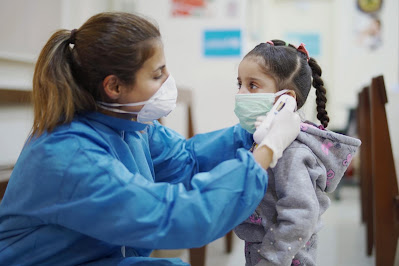But they do get sick, some can die and they can infect others
Yale University
Children and adults exhibit distinct immune system responses to infection by the virus that causes COVID-19, a finding that helps explain why COVID-19 outcomes tend to be much worse in adults, researchers from Yale and Albert Einstein College of Medicine report Sept. 18 in the journal Science Translational Medicine.
A widespread and dangerous immune response to the virus has been linked to acute respiratory distress syndrome, the need for ventilation, and increased mortality in adults with COVID-19. These outcomes are less common in children, which has led to speculation that immune system response to the virus is somehow suppressed.
But the new study,
which examined serum and cell samples obtained from pediatric and adult
patients diagnosed with COVID-19, found that children actually express higher
levels of two specific immune system molecules. The researchers believe this
may contribute to the better outcomes.
"To our surprise, we found these particular serum cytokines were at higher levels in children than adults," said Kevan Herold, the C.N.H. Long Professor of Immunology and Internal Medicine at Yale and co-senior author of the paper.
Intriguingly, the analysis also
showed that certain types of antibody responses thought to be protective were
actually higher in adults, including those with severe cases, than in children,
the research found.
Since the earliest days of the COVID-19 outbreak, scientists have observed that children infected with the virus tend to fare much better than adults.
To determine why that is, Herold,
along with his spouse, Betsy Herold, the co-senior author and a professor of
pediatrics and microbiology-immunology at Albert Einstein College of Medicine,
decided to study blood and cell samples collected from patients of different
ages who were admitted with COVID-19 symptoms to the Montefiore Medical Center
in New York City.
Specifically, they looked for
variations in the types of immune system responses in patients who experienced
different health outcomes from the novel coronavirus. The subjects also
included children and adolescents diagnosed with multi-system inflammatory
syndrome or MIS-C, a rare complication of COVID-19 infection in young people
that is associated with a variety of severe health complications.
They found that levels of two immune
system molecules -- interleukin 17A (IL-17A), which helps mobilize immune
system response during early infection, and interferon gamma (INF-g), which
combats viral replication -- were strongly linked to the age of the patients.
The younger the patient, the higher the levels of IL-17A and INF-g, the
analysis showed.
These two molecules are part of the
innate immune system, a more primitive, non-specific type of response activated
early after infection, Kevan Herold noted. Conversely, the adults showed a more
vigorous adaptive immune system response including higher neutralizing antibody
levels, which record signatures of pathogens and target them for elimination.
They also found that children with rare cases of MIS-C also have high levels of IL-17A and INF-g, but seldom exhibit severe damage to lung tissue that characterizes severe adult cases. These children, however, share other immune response signatures linked to more severe adult cases.
The source of the IL-17A and INF-gmolecules remain unknown,
but its identification may shed light on cells that can be targeted to prevent
severe effects from COVID-19.
Boosting certain types of immune
responses may be beneficial to patients, the authors theorize.
"The suggestion is that kids
have a more robust, earlier innate immune response to the virus, which may
protect them from progressing to severe pulmonary disease," Betsy Herold
said.
